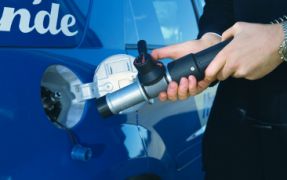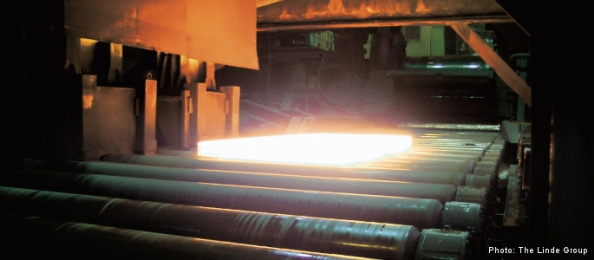The Linde Group - Climate Protection throughout different Process Chains
The Linde Group is a world-leading gases and engineering company with almost 48,000 employees working in around 100 countries worldwide. In fiscal year 2009, it achieved sales of €11.211 billion. The Group comprises two main divisions: Gases and Engineering. The extensive portfolio of the Gases Division ranges from the production of industrial gases to the delivery of processes, plants, equipment, and services for the widest scope of gas applications. We supply many different industries in almost 100 countries across the globe. Our Engineering Division builds plants to process and convert raw materials, also applying its wealth of process know-how to advance the field of renewable energies.
In our Corporate Responsibility and SHEQ policies, we make a firm commitment to protecting the environment, offering safe, eco-friendly products and services and pursuing research and development into particularly sustainable products, services, and technologies.
We regularly measure and evaluate company processes that have an impact on the environment and climate, publishing the results in our annual Corporate Responsibility Report in accordance with internationally approved standards. Measures to support climate protection are in place in both divisions, albeit at different stages of the respective process chains.
Hence lagging indicators (such as the absolute number of patents registered in a fiscal year) do not really capture the big picture. So we have also introduced an Environmental Innovation Performance leading indicator to benchmark our innovative contribution to environmental and climate protection.
Environmentally sound gas applications
The deployment of our industrial gases and process technologies offers numerous opportunities across a wide variety of industries to help customers to reduce the impact of their operations on the environment and climate.
Linde’s oxyfuel technology, for example, which uses almost pure oxygen instead of air for combustion processes, helped one of the world’s largest steel companies to garner the 2009 Energy Achievement Award from the Association for Iron and Steel Technology. The award is presented annually to an individual or organization to recognize their deployment and use of innovative new technologies or practices that result in significant energy conservation improvements in steelmaking. The project with our customer reduced fuel consumption by 60 percent. In addition, over the last two years, Linde’s oxyfuel technology has reduced nitrogen oxide and CO2 emissions by 92 percent and 60 percent respectively. Moreover, it has given the company the chance to increase material throughput by 25 percent.
Gases Division: Resource-efficiency
However, climate protection in the production facilities of our Gases Division focuses primarily on our most energy-intensive plants: air separation units and HyCO plants.
Linde engineers have always looked for new ways to operate air separation plants efficiently by saving energy. Our aim is to continue optimizing energy efficiency so we can reduce indirect CO2 emissions. This has been a major driving force for us in recent years.
A HyCO plant is a collective term for different plants that produce hydrogen and carbon monoxide. The common methods of hydrogen production are steam reforming of natural gas and partial oxidation of heavy hydrocarbons. Our HyCO plants primarily generate direct CO2 emissions through hydrogen synthesis and the use of fuel to reach the reaction temperature required to produce gas. Also here we strive to constantly optimize our production processes.

Photo: The Linde Group
“Green” hydrogen
But Linde’s long-term objective is to generate hydrogen more and more from renewable energy sources using ecologically sound processes. Although natural gas is the main hydrogen feedstock at present, experts are looking for green ways of producing this promising fuel. Biologists, for example, are focusing on cyanobacteria as a way of harnessing photosynthesis to generate hydrogen. Linde’s hydrogen experts on the other hand have developed an innovative process for obtaining hydrogen from glycerine, a byproduct of various processes, including diesel refining.
In addition, Linde has always been a pioneer in the evolution of hydrogen technologies and is committed to further advancing commercialization of this environmentally sound energy carrier. Our expertise today spans the entire process from hydrogen production from fossil and renewable energy sources, through compression and liquefaction, storage, and transport right up to fueling vehicles with compressed and liquefied hydrogen.
To achieve our goals here, we work closely with the automotive industry and fuel companies within the framework of numerous national and international collaborative projects.
Engineering Division: Environmental friendly technologies
In our Engineering Division, climate protection is integrated at management level. Here, climate protection is covered under the Quality, Health, Safety, Environment management program. At the core process level, the spotlight is on the preparation of tenders and plant planning.
The Engineering Division has defined the so-called Health, Safety, Environment (HSE) Essentials, which include central HSE documents that must be completed during the planning phase of every plant engineering project; HSE requirements for construction sites; procedure in the event of unacceptable risks for Linde engineering employees at construction sites not managed by Linde; as well as the use of environmentally-friendly technologies.
This means whenever possible, our Engineering Division offers tried-and-tested process technologies that extend beyond the customer’s Request for Quotation and/or local environmental regulations. Here we always undertake to advise our customers of the benefits of these solutions and demonstrate how they could be integrated in the relevant project to reduce the environmental footprint. This undertaking is an example of how our policies are being put in practice.
Further downstream, our engineering and environmental safety department ensures that the plant is engineered in accordance with customer specifications, applicable laws and statutory regulations, established guidelines and standards, and the latest advances in engineering and environmental safety.
This project description was originally presented in the Global Compact International Yearbook 2010.
Dietlind Freiberg today is Director Corporate Responsibility at McDonalds Germany. before she was in charge for CSR issues at The Linde Group.
About Us // Privacy Policy // Copyright Information // Legal Disclaimer // Contact
Copyright © 2012-2018 macondo publishing GmbH. All rights reserved.
The CSR Academy is an independent learning platform of the macondo publishing group.









